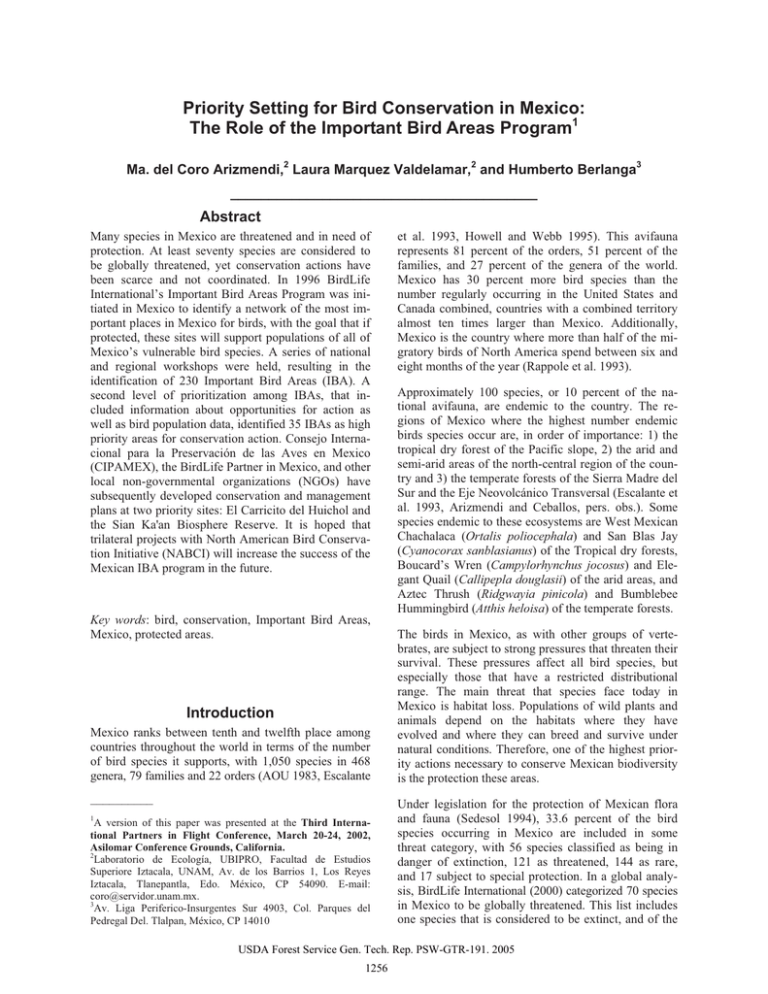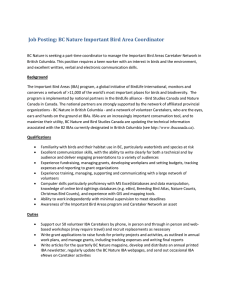Priority Setting for Bird Conservation in Mexico:
advertisement

Priority Setting for Bird Conservation in Mexico: The Role of the Important Bird Areas Program1 Ma. del Coro Arizmendi,2 Laura Marquez Valdelamar,2 and Humberto Berlanga3 ________________________________________ Abstract Many species in Mexico are threatened and in need of protection. At least seventy species are considered to be globally threatened, yet conservation actions have been scarce and not coordinated. In 1996 BirdLife International’s Important Bird Areas Program was initiated in Mexico to identify a network of the most important places in Mexico for birds, with the goal that if protected, these sites will support populations of all of Mexico’s vulnerable bird species. A series of national and regional workshops were held, resulting in the identification of 230 Important Bird Areas (IBA). A second level of prioritization among IBAs, that included information about opportunities for action as well as bird population data, identified 35 IBAs as high priority areas for conservation action. Consejo Internacional para la Preservación de las Aves en Mexico (CIPAMEX), the BirdLife Partner in Mexico, and other local non-governmental organizations (NGOs) have subsequently developed conservation and management plans at two priority sites: El Carricito del Huichol and the Sian Ka'an Biosphere Reserve. It is hoped that trilateral projects with North American Bird Conservation Initiative (NABCI) will increase the success of the Mexican IBA program in the future. Key words: bird, conservation, Important Bird Areas, Mexico, protected areas. Introduction Mexico ranks between tenth and twelfth place among countries throughout the world in terms of the number of bird species it supports, with 1,050 species in 468 genera, 79 families and 22 orders (AOU 1983, Escalante __________ 1 A version of this paper was presented at the Third International Partners in Flight Conference, March 20-24, 2002, Asilomar Conference Grounds, California. 2 Laboratorio de Ecología, UBIPRO, Facultad de Estudios Superiore Iztacala, UNAM, Av. de los Barrios 1, Los Reyes Iztacala, Tlanepantla, Edo. México, CP 54090. E-mail: coro@servidor.unam.mx. 3 Av. Liga Periferico-Insurgentes Sur 4903, Col. Parques del Pedregal Del. Tlalpan, México, CP 14010 et al. 1993, Howell and Webb 1995). This avifauna represents 81 percent of the orders, 51 percent of the families, and 27 percent of the genera of the world. Mexico has 30 percent more bird species than the number regularly occurring in the United States and Canada combined, countries with a combined territory almost ten times larger than Mexico. Additionally, Mexico is the country where more than half of the migratory birds of North America spend between six and eight months of the year (Rappole et al. 1993). Approximately 100 species, or 10 percent of the national avifauna, are endemic to the country. The regions of Mexico where the highest number endemic birds species occur are, in order of importance: 1) the tropical dry forest of the Pacific slope, 2) the arid and semi-arid areas of the north-central region of the country and 3) the temperate forests of the Sierra Madre del Sur and the Eje Neovolcánico Transversal (Escalante et al. 1993, Arizmendi and Ceballos, pers. obs.). Some species endemic to these ecosystems are West Mexican Chachalaca (Ortalis poliocephala) and San Blas Jay (Cyanocorax sanblasianus) of the Tropical dry forests, Boucard’s Wren (Campylorhynchus jocosus) and Elegant Quail (Callipepla douglasii) of the arid areas, and Aztec Thrush (Ridgwayia pinicola) and Bumblebee Hummingbird (Atthis heloisa) of the temperate forests. The birds in Mexico, as with other groups of vertebrates, are subject to strong pressures that threaten their survival. These pressures affect all bird species, but especially those that have a restricted distributional range. The main threat that species face today in Mexico is habitat loss. Populations of wild plants and animals depend on the habitats where they have evolved and where they can breed and survive under natural conditions. Therefore, one of the highest priority actions necessary to conserve Mexican biodiversity is the protection these areas. Under legislation for the protection of Mexican flora and fauna (Sedesol 1994), 33.6 percent of the bird species occurring in Mexico are included in some threat category, with 56 species classified as being in danger of extinction, 121 as threatened, 144 as rare, and 17 subject to special protection. In a global analysis, BirdLife International (2000) categorized 70 species in Mexico to be globally threatened. This list includes one species that is considered to be extinct, and of the USDA Forest Service Gen. Tech. Rep. PSW-GTR-191. 2005 1256 The IBA Program in México - Arizmendi et al. remaining species, eight are critically threatened, 12 are in danger of extinction, 19 are vulnerable, 28 are near threatened, and two are potentially threatened but there is insufficient information to determine their status. Despite the lack of detailed information about bird populations in many regions in the world, it has been documented that in the last four centuries approximately 105 bird species have gone extinct, which is equivalent to about 1 percent of the world total (Bibby 1995, IUCN 1996). In Mexico four species have gone extinct in recent times. The main causes of these extinctions have been the introduction of exotic species, hunting, and the destruction of critical habitat (Escalante et al. 1993, Ceballos and Marquez-Valdelamar 2000). Other factors such as pollution and the illegal traffic of species for the pet trade have been identified as severe threats for species already in danger of extinction. These factors may have contributed to the extinction of some species, but there is no detailed information available to confirm this. The number of birds considered to be at risk of extinction in Mexico has increased in recent years. For example, Aguilar-Ortiz (1979) reported 31 species in danger of extinction. Soon after, the International Council for Bird Preservation (King 1981) included 35 Mexican species on its threatened species list. The availability of more detailed information allowed the Mexican partner of the former International Council for Bird Preservation (currently known as BirdLife International) to classify the threat status of 117 species, of which 35 were considered to be in danger of extinction, 27 were classified as threatened, and 55 were listed as prone to extinction (CIPAMEX 1989). More recently, BirdLife International (2000) identified 70 Mexican species as globally threatened, as detailed above. However, in spite of the high diversity of Mexican birds and the multiple threats they face, conservation actions have been scarce and not coordinated. In 1996 the Important Bird Areas (IBA) Program was initiated in Mexico as part of a trilateral project between Mexico, USA and Canada within the framework of the North American free trade of commerce agreement (NAFTA). The main objective of the Important Bird Areas Program (referred to in Spanish as AIAs - Areas Importantes para las Aves, or AICAs - Areas Importantes para la Conservaciòn de las Aves) is to identify a global network of places that are important for the longterm sustainability of the populations of birds they support. IBAs/AIAs/AICAs are: x x Practical tools for conservation. x Chosen using standardized criteria. x Not appropriate for the conservation of all species. As general guidelines IBAs should: x Be sufficiently large (wherever possible) to support viable populations of the species for which they are important. x Be feasible to conserve x Include, where appropriate, the existing network of protected natural areas. x Be included in regional conservation and/or management plans. By identifying the places of most importance for the conservation of the birds, the IBA Program serves as a useful tool for identifying gaps in a country’s system of protected natural areas. In most cases IBAs are identified by using existing information that is compiled for this purpose. IBA data are then used to inform management plans and regional conservation strategies. The IBA Identification Process The first step of the Mexican IBA program was to form a steering committee, led by the IBA coordinator. This committee includes many stakeholders, including representatives of both academic and the government institutions (fig. 1). An initial IBA workshop was held in Oaxaca in 1996 to initiate the IBA identification process. Approximately 40 experts representing universities and nongovernmental organizations from throughout Mexico met to propose areas of importance for the conservation of the birds (fig. 2). In this workshop 170 areas were nominated, using criteria initially developed by BirdLife International (Estrada and Davidson, this volume). During 1996-1997 those 170 areas were reviewed by the national coordinator, along with 23 additional sites subsequently nominated by other ornithologists. These nominations were revised as further information became available and information about each site was entered into the Mexican IBA database which is maintained by CONABIO. Maps of all nominated areas were digitized by the staff in the CONABIO office (National Commission for the Knowledge and Use of Biodiversity) and incorporated into a geographical information system (ARCHINFO scale 1: 250,000). Places of international significance for the conservation of bird species. USDA Forest Service Gen. Tech. Rep. PSW-GTR-191. 2005 1257 The IBA Program in México - Arizmendi et al. Figure 1— Structure and internal organization of the IBA Program in Mexico. Figure 2ņ Flow chart of the development of the IBA Program in Mexico. USDA Forest Service Gen. Tech. Rep. PSW-GTR-191. 2005 1258 The IBA Program in México - Arizmendi et al. In a May 1997 meeting of the IBA Steering Committee, the national coordinator and technicians of CONABIO revised, with the support of maps of vegetation, topography and hydrography, the boundaries of the 193 proposed IBAs. We created a map which can be consulted in an electronic format at http:// conabioweb.conabio.gob.mx/aicas/doctos/aicas.html, where all information about the IBAs is available. In 1998 the IBA program entered a second phase during which the country was partitioned into four regions for planning purposes (Northeast, Northwest, South and Center). In each region two workshops were held to revise the list of IBAs, based on input from the larger number of regional experts that attended these meetings. IBAs were added, aggregated, or eliminated, resulting in a definitive list of 230 IBAs (fig. 3). Figure 3ņ IBAs designated in Mexico (1996-2000). Each IBA is documented in a technical description that includes biotic and abiotic information about the area, in addition to a bird list that includes the species, their abundance (categorically) and their seasonal occurrence in the area. The complete database of 230 IBAs includes more than 22,000 records of 1,038 species of birds (96.3 percent of the total species regularly occurring in Mexico according to the American Ornithologist Union 1983). Additionally, 90.2 percent (306 of 339 species) of the species listed as threatened according to Mexican law, and 100 percent of the species included in Threatened Birds of the World (BirdLife International 2000) occur in at least one IBA. Moreover, of the 100 species endemic to Mexico (Navarro and Benitez 1993) all occur in at least one IBA. Finally, all vegetation types recorded in Mexico (Rzedowski 1978) also are present in one or more IBAs. All of Mexico’s Biosphere Reserves, Special Reservations, and Biological Stations have been nominated as IBAs. Also, 121 Priority Regions for Conservation (Arriaga et al. 2000) are recognized as IBAs (63 percent of total regions). IBAs have been identified in all the states of the Mexican republic; nonetheless, some states appear to be over- or under-represented (fig. 3). This is partially a reflection of unequal ornithological knowledge among the states, and it therefore highlights an important agenda for future field work. From Identification to Conservation Practice: The Prioritization Exercise By definition, the IBA process identifies sites that are priorities for conservation action. However, implementing conservation plans in all the IBAs is likely to be impossible or at least impractical in the near future. Therefore, we decided to develop a set of national criteria for prioritizing which IBAs would be most important and practical to work in first. We scored each IBA based on eleven criteria (table 1), which included, for example, bird species richness, presence of endemic and/or threatened birds, and the presence of opportunities for implementing conservation measures (defined as the presence and local people and/or institutions with positive attitudes towards conservation). For each IBA, the scores for all eleven criteria were added to produce a site priority score, and all the IBAs were then ranked by these scores to determine priorities among the IBAs. Sixteen IBAs where classified as priority areas for bird conservation in Mexico (fig. 4). If we succeed in sustaining the target bird populations in all 16 priority IBAs we will be conserving 805 species (75 percent of the Mexican avifauna), including 55 percent of Mexico’s globally threatened species and 81 percent of Mexico’s endemic species. This goal, however, is not sufficient. Our priority as a country is to preserve all the Mexican endemic bird species, as defined by Navarro and Benitez (1993), and ensure the conservation of all the Mexican bird species listed as globally threatened (BirdLife International 2000). Therefore, to further prioritize IBAs we queried the IBA database for sites supporting any endemic or globally threatened species. Sites supporting the largest component of these species were listed as priority sites. This list was supplemented by additional sites that supported other priority species that had been missed, until a subset of IBAs was identified that supported all priority species. This process generated a list of 19 additional priority sites (table 2). USDA Forest Service Gen. Tech. Rep. PSW-GTR-191. 2005 1259 The IBA Program in México - Arizmendi et al. Table 1— Criteria used for prioritizing IBAs for conservation actions in Mexico. Each criterion was subjectively weighted by the associated score to reflect its perceived importance for ranking priorities. Priorities were obtained for each IBA by adding the scores for each criterion that was met at a site. Criteria Global importance based on IBA criteria (Presence of globally threatened species, range-restricted species, biomerestricted species, or populations of congregatory species exceeding 1% of global population) Presence of opportunities to manage and conserve the IBA (Presence of local landowners who are actively working towards conservation and sustainable development) Existence of a management and/or conservation plan for the IBA Presence of an effective local conservation group Presence of priority vegetation types Size of the IBA (ha) Presence of infrastructure (roads, communications, etc) Biological richness (4) of birds (number of species) Presence of range-restricted (endemic) bird species Site of migrant bird concentration Site of breeding bird concentration Score 5 5 4 4 3 0-4,999 = 1 5,000-10,000 = 2 > 10,000 = 3 3 0-50 = 0 51-100 = 1 101-250 = 2 > 251 = 3 Endemic to México = 1 Endemic to the region = 2 Endemic to the state = 3 3 3 Table 2— Priority IBAs for bird conservation in Mexico. A: Based on site criteria Center: Cuitzeo, Islas Revillagigedo, Tehuacán, Chamela-Cuitzmala and Omiltemi. North-East: Sierra de Arteaga, El Potosí, Peña Nevada, Pradera de Tokio and El Cielo. North-West: Marismas Nacionales, Isla Tiburón and Archipiélago Loreto. South: El Triunfo, Sian Ka’an and Río Lagartos. B: Based on species criteria Cañón de Lobos Centro de Veracruz El Ocote Isla Benitos Islas Marías Lagos de Montebello Reserva El Pinacate y Gran desierto de Altar Sierra de Atoyac Sierra de Miahuatlán Sierra Norte First Steps Towards Implementing Conservation Actions The first IBA for Mexico, El Carricito del Huichol, an old-growth pine forest, represents one of the few remnants of this vegetation type growing in the western coast of Mexico that still preserves its biological integrity. Carricito del Huichol Cerro de Oro Estero San Jose Isla Guadalupe La Sepultura Las Bufas Sur del Valle de México Sierra de Manantlán Sierra de Santa Martha This area has been the focus of attention by CIPAMEX since 1997. The main goal here was to promote the development of a conservation and manage plan that will enable local landholders (private and indigenous) to make a living from their lands without damaging the environment. Some actions have been implemented, USDA Forest Service Gen. Tech. Rep. PSW-GTR-191. 2005 1260 The IBA Program in México - Arizmendi et al. Figure 4ņ Priority IBAs for México. such as the building of a field station where both scientists and tourists are welcome to conduct surveys or birdwatch. These activities benefit the huicholes who inhabit the land. This project grew so fast that in 1998, a new NGO (Bosque Antiguo AC) was formed to deal specifically with the conservation of this area. In the near future management plans will be developed for four more IBAs, one in each of the four regions in Mexico, with the goal of quickly implementing conservation actions in those areas. More recently, a second area, the Sian Ka´an Biosphere Reserve in the Yucatan Peninsula, was adopted as a cooperative sister project by Panama, Mexico and Canada. This project, building on a long history of related projects in the area by Amigos de Sian Ka’an A.C., involves the development of ecotourism, based on birding tours, as an alternative for communal development in the area. In this way Amigos de Sian Ka´an A. C., along with the Director of the biosphere reserve and CIPAMEX, conducted workshops in two local communities to train nature guides. Trails for bird observation were built and promoted throughout Mexico by CIPAMEX, and at the international level by our Canadian partner, the Canadian Nature Federation. By the end of 2002 this initiative, along with efforts of many organizations and people working towards bird conservation in the Yucatan Peninsula, had grown into a NABCI pilot project. Opportunities for the Conservation of Birds in Mexico: The Role of the IBA Program The publication of a directory of Mexico’s Important Bird Areas in 2000 (Arizmendi and Marquez 2000) was truly a benchmark in the history of Mexican ornithology. However, the IBA Program also has provided Mexico with a unique opportunity for initiating new and exciting cooperative efforts among many people and organizations interested in the study and conservation of the Mexican birds. The IBA Program, besides being a tool for the conservation community and the Mexican government, serves as a starting point for the formulation of conservation plans within NABCI: a trilateral initiative that is working towards the implementation of coordinated conservation actions throughout North America. In Mexico, USDA Forest Service Gen. Tech. Rep. PSW-GTR-191. 2005 1261 The IBA Program in México - Arizmendi et al. IBAs will be the primary implementation units for NABCI. The successes that have been achieved by the IBA Program in Mexico have occurred within the context of recent changes in the government, non-governmental organizations, the private sector, and the overall social structure of the country, which have created a climate conducive to these achievements. The IBA Program therefore represents an important example of the positive impact a program can have when it has the consensus of many institutions and people working to achieve one common goal – the conservation of our birds. Acknowledgments We want to acknowledge the work of A. Estrada and D. Niven who provided excellent editorial comments that improved the present manuscript. We thank BirdLife International for their support in several phases of this work and especially the Americas office whose personnel helped a lot in the elaboration of the present work. We also thank Partners in Flight and the Mexican NABCI project for the financial support given to Ma. Del Coro Arizmendi for attending in the Asilomar Conference. Bibby, C. J. 1995. Recent past and future extinctions in birds. In: J. H. Lawton and R. M. May, editors. Oxford, NY: Oxford University Press; 98-110. BirdLife International. 2000. Threatened birds of the world. Barcelona and Cambridge, UK: Lynx Editions and BirdLife International. Ceballos, G. and L. Márquez-Valdelamar, editors. 2000. Las Aves de México en peligro de extinción. México: Comisión Nacional Para el Conocimiento y Uso de la Biodiversidad (CONABIO)-Intituto de Ecología, Universidad Nacional Autómoma de México-Fondo de Cultura Económica. CIPAMEX (Consejo Internacional para la Preservación de las Aves en México). 1989. Aves mexicanas posibles de clasificarse como amenazadas o en peligro de extinción. Cuauhtli 1: 7-8. Escalante, P. P., A. G. Navarro and A. T. Peterson. 1993. A geographic, ecological and historical analysis of land bird diversity in México. In: T. P. Ramamoorthy, R. Bye, A. Lot, and J. Fa, editors. Biological diversity of México: origins and distributions. Oxford, NY: Oxford University Press; 281-307. Howell, S. N. and S. Webb. 1995. A guide to the birds of México and Central America. Oxford, NY: Oxford University Press; 855 p. International Union for the Conservation of Nature and Natural Resources (IUCN). 1996. Red list of threatened animals. Gland, Switzerland: IUCN. King, W. B. 1981. Endangered birds of the world, The ICBP Bird red data book. Washington, DC: Smithsonian Institution Press. Literature Cited Aguilar-Ortiz, F. 1979. Aves en peligro de extinción: Un llamado a la investigación para la sobrevivencia. Veracruz, México: Cuaderno de Divulgación Instituto des Investigacionares sobre los Recursos Bioticos (INIREB); 13 p. American Ornithologists’ Union (AOU). 1983. Check-list of North American Birds. 6th ed. Washington, DC: American Ornithologists Union. Arizmendi, M. C. and L. Marquez Valdelamar, editors. 2000. Áreas de Importancia para la Conservación de las Aves en México. México D.F.: Consejo Internacional para la Preservación de las Aves en México (CIPAMEX); 440 p. Arriaga, L., J. M. Espinoza, C. Aguilar, E. Martínez, L. Gómez and E. Loa, coordinators. 2000. Regiones terrestres prioritarias de México. Comisión Nacional para el Conocimiento y uso de la Biodiversidad. México. Navarro, S. A. G. and H. Benitez. 1993. Patrones de riqueza y endemismo de las aves. Revista Ciencias 7: 45-54. Rappole, J. H., E. S. Morton. T. E Lovejoy, and J. L. Rous. 1993. Aves migratorias nearticas en los neotropicos. Front Royal, VA: Conservation and Research Center, National Zoological Park, Smithsonian Institution.. Rzedowski, J. 1978. Vegetación de México. México D.F.: Editorial Limusa. Sedesol. 1994. Norma Oficial Mexicana (NOM-059-ECOL1994) que determina las especies y subespecies de flora y fauna silvestres terrestres y acuáticas en peligro de extinción, amenazadas, raras y sujetas a protección especial y que establece especificaciones para su protección. Diario Oficial de la Federación 488 (10): 2-60. USDA Forest Service Gen. Tech. Rep. PSW-GTR-191. 2005 1262







